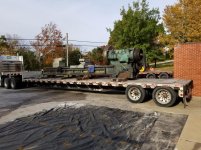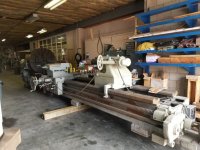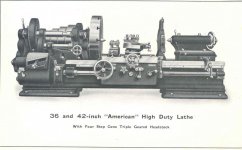A? I suspect those are D belts. If you don't have the belts, I'll wager the cost of new belts will exceed the purchase price of the entire lathe for over half of PM's viewership.
Looks like a fun machine.
Could was. Not an ATW mavin here.
Vee belts, OTOH, would "work" even if designed for "A" section (circa 5 HP each, load-meter buried) and not need to be any more than "B" for the row-count and generous wrap-run @ 40 HP "max" and sub 200 RPM spindle speed that was in effect the brochure John linked.
Present-day costs, however, are indeed "non-trivial" anything greater than "A" and
matched.
If I had to run it? I'd back-convert to flat belting that I could DIY in arbitrary-wide and affordable material. I'd make a "steel tire" of heavy-wall tubing or rolled and welded plate to put right OVER those Vee sheaves. Same again at the motor.
Lathes this size, steam rail and big mills long gone, deep mining minimized, tend to spend much of their remaining lives laid-up silently in ambush .. waiting ...for those big jobs that pay well, but just doen't show up every day of the week. Nor even every month of a given year.
Galis' six-footer ate but once a
year or so. Mind, bugger was built in the 1880's, so by the 1960's it no longer OWED anybody a dime. Just had to justify the floor space. And it surely did that, given how few other shops had the ability to put a 100 ton crane's whole base carriage up on the machine to turn the turret-ring for a new Timken!








 )
)
